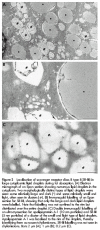Scavenger receptor class B type I (SR-BI) in pig enterocytes: trafficking from the brush border to lipid droplets during fat absorption
- PMID: 12970134
- PMCID: PMC1773834
- DOI: 10.1136/gut.52.10.1424
Scavenger receptor class B type I (SR-BI) in pig enterocytes: trafficking from the brush border to lipid droplets during fat absorption
Abstract
Background: Scavenger receptor class B type I (SR-BI) is known to mediate cellular uptake of cholesterol from high density lipoprotein particles and is particularly abundant in liver and steroidogenic tissues. In addition, SR-BI expression in the enterocyte brush border has also been reported but its role in the small intestine remains unclear.
Aim and methods: To gain insight into the possible function of pig SR-BI during uptake of dietary fat, its localisation in enterocytes was studied in the fasting state and during fat absorption by immunogold electron microscopy and subcellular fractionation.
Results: In the fasting state, SR-BI was mainly localised in the microvillar membrane and in apical invaginations/pits between adjacent microvilli. In addition, a subapical compartment and small cytoplasmic lipid droplets were distinctly labelled. During lipid absorption, the receptor was found in clathrin positive apical coated pits and vesicles. In addition, cytoplasmic lipid droplets that greatly increased in size and number were strongly labelled by the SR-BI antibody whereas apolipoprotein A-1 positive chylomicrons were largely devoid of the receptor.
Conclusion: During absorption of dietary fat, SR-BI is endocytosed from the enterocyte brush border and accumulates in cytoplasmic lipid droplets. Internalisation of the receptor occurs mainly by clathrin coated pits rather than by a caveolae/lipid raft based mechanism.
Figures







Similar articles
-
Role of scavenger receptors SR-BI and CD36 in selective sterol uptake in the small intestine.Biochemistry. 2001 Sep 25;40(38):11643-50. doi: 10.1021/bi0109820. Biochemistry. 2001. PMID: 11560515
-
Class B scavenger receptor-mediated intestinal absorption of dietary beta-carotene and cholesterol.Biochemistry. 2005 Mar 22;44(11):4517-25. doi: 10.1021/bi0484320. Biochemistry. 2005. PMID: 15766282
-
Localization of the lipid receptors CD36 and CLA-1/SR-BI in the human gastrointestinal tract: towards the identification of receptors mediating the intestinal absorption of dietary lipids.J Histochem Cytochem. 2001 Oct;49(10):1253-60. doi: 10.1177/002215540104901007. J Histochem Cytochem. 2001. PMID: 11561009
-
The role of scavenger receptor class B type I (SR-BI) in lipid trafficking. defining the rules for lipid traders.Int J Biochem Cell Biol. 2004 Jan;36(1):39-77. doi: 10.1016/s1357-2725(03)00173-0. Int J Biochem Cell Biol. 2004. PMID: 14592533 Review.
-
The role of the high-density lipoprotein receptor SR-BI in cholesterol metabolism.Curr Opin Lipidol. 2000 Apr;11(2):123-31. doi: 10.1097/00041433-200004000-00004. Curr Opin Lipidol. 2000. PMID: 10787173 Review.
Cited by
-
Vitamin E Bioavailability: Mechanisms of Intestinal Absorption in the Spotlight.Antioxidants (Basel). 2017 Nov 22;6(4):95. doi: 10.3390/antiox6040095. Antioxidants (Basel). 2017. PMID: 29165370 Free PMC article. Review.
-
Accelerated lipid absorption in mice overexpressing intestinal SR-BI.J Biol Chem. 2006 Mar 17;281(11):7214-9. doi: 10.1074/jbc.M508868200. Epub 2006 Jan 18. J Biol Chem. 2006. PMID: 16421100 Free PMC article.
-
Exposure to dietary lipid leads to rapid production of cytosolic lipid droplets near the brush border membrane.Nutr Metab (Lond). 2016 Jul 28;13:48. doi: 10.1186/s12986-016-0107-9. eCollection 2016. Nutr Metab (Lond). 2016. PMID: 27478484 Free PMC article.
-
Luminal lipid regulates CD36 levels and downstream signaling to stimulate chylomicron synthesis.J Biol Chem. 2011 Jul 15;286(28):25201-10. doi: 10.1074/jbc.M111.233551. Epub 2011 May 24. J Biol Chem. 2011. PMID: 21610069 Free PMC article.
-
Absorption of vitamin A and carotenoids by the enterocyte: focus on transport proteins.Nutrients. 2013 Sep 12;5(9):3563-81. doi: 10.3390/nu5093563. Nutrients. 2013. PMID: 24036530 Free PMC article. Review.
References
-
- Krieger M. Charting the fate of the “good cholesterol”: identification and characterization of the high-density lipoprotein receptor SR-BI. Annu Rev Biochem 1999;68:523–58. - PubMed
-
- Silver DL, Tall AR. The cellular biology of scavenger receptor class B type I. Curr Opin Lipidol 2001;12:497–504. - PubMed
-
- Acton SL, Scherer PE, Lodish HF, et al. Expression cloning of SR-BI, a CD36-related class B scavenger receptor. J Biol Chem 1994;269:21003–9. - PubMed
-
- Trigatti BL, Rigotti A, Braun A. Cellular and physiological roles of SR-BI, a lipoprotein receptor which mediates selective lipid uptake. Biochim Biophys Acta 2000;1529:276–86. - PubMed
Publication types
MeSH terms
Substances
LinkOut - more resources
Full Text Sources
Medical
Research Materials
